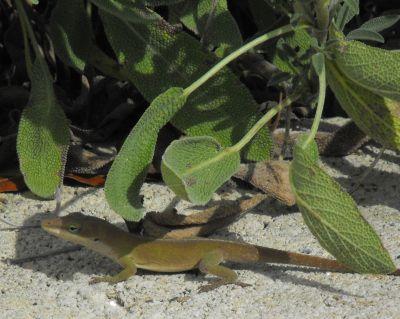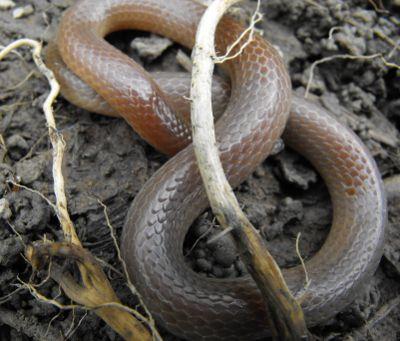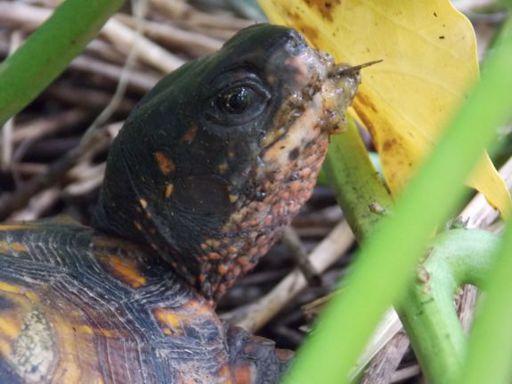Naturally Bug-Free (7 page)
Read Naturally Bug-Free Online
Authors: Anna Hess

Whole books exist on the topic of encouraging birds in your garden, but the gist usually boils down to providing them with nesting habitat, protective cover (bushes, hedges, or brush piles), and food. I'll just add two brief notes that are of particular interest for gardeners hoping to attract insect-eating birds to their yards. First, man-made houses are especially handy for cavity-nesters like bluebirds, since you can make the entrance hole just the right size to attract the species you're looking for. And, second, birdseed isn't the right feeding solution for many of the insect eaters—instead, you'll want to allow prey insects to live at low levels just like you did to promote predatory insects.

 Most lizards are insect-eaters. The top photo shows a fence lizard climbing up a window screen, while the bottom photo captures an anole under a sage plant.
Most lizards are insect-eaters. The top photo shows a fence lizard climbing up a window screen, while the bottom photo captures an anole under a sage plant.
Lizards, like birds, are generally friends of the garden. Large lizards in other parts of the world (such as iguanas) may consume plants, but the little lizards most of us are familiar with prefer eating insects, spiders, centipedes, snails, other lizards, and young mice. Maybe they even eat baby voles? In any case, you can encourage lizards by providing small crevices in which they can hide. Rock piles and dry-stone walls are good shelters for lizards, and skinks (a type of lizard) particularly enjoy hiding out between logs in our woodshed.
 The eastern worm snake spends much of its time underground hunting earthworms. The snake also looks very much like a large worm when you dig it up.
The eastern worm snake spends much of its time underground hunting earthworms. The snake also looks very much like a large worm when you dig it up.

Worms make up 80% of an average garter snake's diet.

Ring-neck snakes prefer eating salamanders, but they will also consume earthworms, snakes, lizards, and frogs.
Gardeners tend to be afraid of snakes, but many of these slender creatures are actually vital parts of the ecosystem, acting as predators of worms and other ground-dwelling invertebrates and (in some cases) loosening the soil as they burrow through the earth. My stance on snakes is very similar to my stance on garden insects—I know how to identify the poisonous snakes that live in my area, and then I assume every other snake I see is good. Here in southwest Virginia, only rattlesnakes and copperheads have dangerous bites, and both are rare in the garden.
How do you encourage beneficial snakes like the ones shown above? Brian Cooper wrote in to say: "A couple years ago, I started lining my garden beds with logs from fallen tree branches (~6" in diameter) to allow for some moisture retention and to keep mulch in the beds while defining the paths. What I did not realize was that I was making a perfect home for earth snakes. This year, for the first time, I saw one while I was digging out our swale paths and accidentally disturbed one of these edge logs. These snakes are reported to eat arthropods and slugs, like to live underground, and can be found under logs." Other ways to encourage snakes include making rock or wood piles as you would for lizards, providing brushy cover as you would for birds, and leaving the ground alone as you would for soil workers.
 Although they
Although they
will
take a bite out of your tomatoes, box turtles are generally friends of the garden since they love to eat snails and slugs.

Box turtles lay their eggs in loose soil, especially in the rotting wood of hugelkultur mounds. Once we started adding wood to our forest garden, baby box turtles turned up year after year.
While snakes and lizards are nearly all allies of the garden, I'd have to say that box turtles (the most common turtle found in gardens in the eastern U.S.) are neutral. Box turtles have a tendency to visit tomato patches, where they take one bite out of each ripe fruit, which can drive some gardeners crazy. Carry the turtles away, and they'll slowly but surely walk back to your garden and continue eating those tomatoes, and then they'll head over to clean up the dropped berries under your raspberry plants. On the other hand, if you can handle a few nibbles on your fruits, box turtles will pay their way by consuming large amounts of problematic snails and slugs (as well as friendly earthworms), so I enjoy seeing these shelled reptiles in my garden. Box turtles move into the same kinds of environments snakes and lizards enjoy, but turtles are particularly sensitive to chemical use.

 Since their tadpoles live in water before turning into adults, frogs and toads are easy to attract by providing a pond or other body of water.
Since their tadpoles live in water before turning into adults, frogs and toads are easy to attract by providing a pond or other body of water.
Gardeners may have mixed feelings about reptiles, but amphibians are usually welcomed with open arms. And with reason—frogs and toads live entirely on invertebrates like insects, spiders, centipedes, millipedes, snails, and earthworms. To attract toads, many books recommend making houses out of upturned flowerpots with a door broken out of one side, but I've found that these warty amphibians prefer hanging out under the mulch in my vegetable garden instead. Toads became even more plentiful in my yard after I installed a small water garden.

